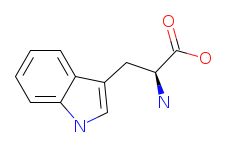Tryptophan
Tryptophan was discovered by Frederick Hopkins in 1901 as an aromatic amino acid. Hopkins isolated this amino acid from a pancreatic digest of casein - 4-8 grams from 600 grams of crude casein.
Chemical Structure of L-Tryptophan

Identifiers and properties of Tryptophan
IUPAC Name: (2S)-2-Amino-3-(1H-indol-3-yl)propanoic acid
Symbol: Three-letter code - Trp. One-letter code - W
Molecular Weight (Molar Mass): 204.22518 g/mol
Molecular Formula (Structural Formula): C11H12N2O2
Canonical SMILES: C1=CC=C2C(=C1)C(=CN2)CC(C(=O)O)N
Isomeric SMILES: C1=CC=C2C(=C1)C(=CN2)C[C@@H](C(=O)O)N
InChIKey Identifier: QIVBCDIJIAJPQS-FKOBDKTLDJ
CAS Number: 73-22-3
MDL Number: MFCD00064340
Melting point: 280-285 °C
RNA codons: TGG
Solubility in water: 11,4 g/L (20 °C); pKa - 2,83; pKb - 9,39
Rf value in n-butanol/acetic acid/water = 12:3:5 - 0.66
2D Molfile: Get the molfile
3D PDB file: Get the PDB file
Other names: TRP; 2-Amino-3-(1H-indol-3-yl)propanoic acid; (S)-2-Amino-3-(3-indolyl)propionic acid; L- alpha-Amino-3-indolepropionic acid; alpha'-Amino-3-indolepropionic acid; Indole-3-alanine; Indole-3-propionic acid, alpha-amino-; 1-beta-3-Indolylalanine; Propionic acid, 2-amino-3-indol-3-yl-
Tryptophan is an essential amino acid, indicating that you need it but you cannot produce it yourself. So, this amino acid should be obtained through dietary means.
Functions of Tryptophan in the body
Today Tryptophan is recognized as the essential building block for numerous life-giving biomolecules, like enzymes, structural proteins, serotonin, melatonin, and the neurotransmitters. Serotonin is responsible for lots of diverse physiological functions like affective disorders, pain perception, sleep, temperature and blood pressure. This amino acid has been recognized as a possible mediator of central fatigue.
Tryptophan can be obtained from plant or animal sources and is widely used in alternative medicine to help treat insomnia, anxiety, depression, and even PMS. Besides, this amino acid is used for smoking cessation and for other conditions. It is known worldwide for relieving minor PMS, for enhancing relaxation and sleep, for soothing nerves and anxiety, and for reducing carbohydrate cravings. Tryptophan is also vital for the production process of serotonin, which is a brain chemical involved in regulating mood. Therefore, when you suffer from depression, there may be a decreased amount of serotonin released from the nerve cells into your brain. Meanwhile, Tryptophan is able to enhance the serotonin's antidepressant effect by increasing the amount of serotonin in your blood.
Benefits of Tryptophan
Among other benefits of this amino acid there are facts that Tryptophan helps treating menopausal depressive conditions, as well as alleviating the symptoms of restless leg syndrome. In addition, it assists in controlling the hyperactivity in children and relieves stress. This amino acid is also recognized for being involved in the body's regulation of sleep: increasing Tryptophan levels may help you normalize sleep patterns. The researches also point out that people suffering from migraine headaches should regulate their levels of Tryptophan.
Dietary sources
Various commonly consumed foods serve as significant sources of tryptophan. Here are examples, along with serving sizes and estimated tryptophan content per serving.
Legumes and Tofu. Tofu (1/2 cup): 296 mg. Soybeans (edamame, 1 cup): 270 mg.
Fish and Seafood. Tilapia (3 ounces): 231 mg. Tuna (canned white, 3 ounces): 252 mg. Snapper (3 ounces): 250 mg. Salmon (farmed, Atlantic, 3 ounces): 211 mg. Lobster (3 ounces): 248 mg. Crab (blue, 3 ounces): 192 mg. Oysters (Pacific, 3 ounces): 90 mg.
Meat and Poultry. Pork roast (3 ounces): 238 mg. Turkey (light meat, 3 ounces): 214 mg. Beef roast (3 ounces): 229 mg. Chicken breast (3 ounces): 77 mg.
Dairy and Eggs. 2% milk (1 cup): 120 mg. Mozzarella cheese (1 ounce): 146 mg. Whole milk (1 cup): 107 mg. Cheddar cheese (1 ounce): 90 mg. Yogurt (low fat, 8 ounces): 68 mg Egg (whole, 1 large): 83 mg.
Grains. Quinoa (1 cup): 284 mg. Oats (1 cup): 147 mg. Buckwheat (groats, 1 cup): 82 mg. Wheat bread (1 slice): 19 mg. White bread (1 slice): 22 mg.
These values are approximate and can vary based on factors such as cooking methods, specific varieties of food, and preparation techniques. If you have specific health concerns or conditions that may require additional tryptophan, it's advisable to consult with a healthcare professional or a registered dietitian for personalized advice.